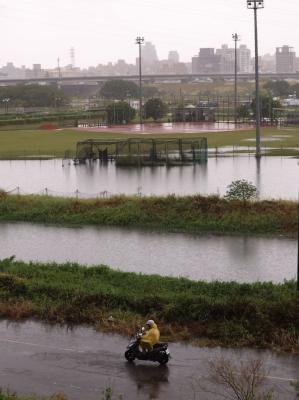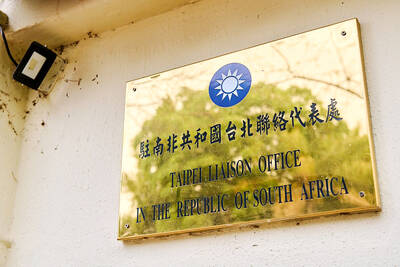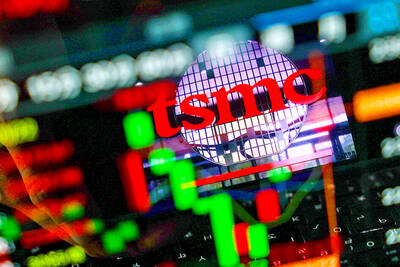The Executive Yuan yesterday said that more deliberation was needed before a proposal to have the national emblem changed could be reviewed by the Ministry of the Interior.
Lawmakers at an extraordinary session at the legislature in Taipei on Friday voted to request an evaluation report from the ministry on the issue, saying that the emblem is too similar to that of the Chinese Nationalist Party (KMT).
The New Power Party (NPP) — which initiated the vote — said that the national emblem causes confusion over Taiwan’s status as a multiparty state, and was inappropriate given the nation’s 30 years of democratization.

Photo: Lee Hsin-fang, Taipei Times
It called on the ministry to report on the issue within two months.
The resolution passed 63-37, with votes cast along party lines, with the NPP and the Democratic Progressive Party (DPP) voting for it, and the KMT voting against, while the five members of the Taiwan People’s Party abstained.
The resolution’s text says that the national emblem is “easily confused” with the KMT’s emblem, arguing that the similarity is improper 30 years after Taiwan’s transition to democracy, as it represents only a portion of Taiwanese.
Executive Yuan Secretary-General Li Meng-yen (李孟諺) said that while he agreed the emblems are similar, which could cause confusion, changing the national emblem would be contentious.
Lawmakers must proceed prudently, slowly and only after collecting feedback, Li said.
“Taiwan’s passports were recently redesigned, and the new design incorporates the national emblem,” he said, adding that changing it would mean paying to replace everything bearing the current emblem.
The KMT Central Standing Committee in 1928 passed a bill to make the anthem, emblem and flag of the KMT those of the Republic of China (ROC), and in so doing passed the National Emblem and National Flag of the Republic of China Act (中華民國國徽國旗法).
The KMT and national emblems portray a white sun over a blue background, but in the KMT emblem, the sun is larger and its 12 rays touch the outer edge of the blue circle that encompasses them.
The national emblem is used on uniforms and documents used by the military, on documents used by government agencies, on the country’s passport and on the flag used by the nation’s Olympic teams.
Former president Ma Ying-jeou (馬英九) said that the issue of the emblems’ similarity had already been addressed.
“The national emblem is described in the National Emblem and National Flag of the Republic of China Act, and it was defined after the KMT’s emblem,” he said.
Former New Taipei City mayor Eric Chu (朱立倫) said that the resolution was an act of “Taiwanese independence.”
“Could the pan-green camp stop putting on an act? If they change the national emblem, the next thing they change will be the national flag and then the country’s name,” Chu said.
“If they want to engage in independence activities, they should just clearly say so,” he said.
Additional reporting by Chen Yun and CNA

Taipei, New Taipei City, Keelung and Taoyuan would issue a decision at 8pm on whether to cancel work and school tomorrow due to forecasted heavy rain, Keelung Mayor Hsieh Kuo-liang (謝國樑) said today. Hsieh told reporters that absent some pressing reason, the four northern cities would announce the decision jointly at 8pm. Keelung is expected to receive between 300mm and 490mm of rain in the period from 2pm today through 2pm tomorrow, Central Weather Administration data showed. Keelung City Government regulations stipulate that school and work can be canceled if rain totals in mountainous or low-elevation areas are forecast to exceed 350mm in

EVA Airways president Sun Chia-ming (孫嘉明) and other senior executives yesterday bowed in apology over the death of a flight attendant, saying the company has begun improving its health-reporting, review and work coordination mechanisms. “We promise to handle this matter with the utmost responsibility to ensure safer and healthier working conditions for all EVA Air employees,” Sun said. The flight attendant, a woman surnamed Sun (孫), died on Friday last week of undisclosed causes shortly after returning from a work assignment in Milan, Italy, the airline said. Chinese-language media reported that the woman fell ill working on a Taipei-to-Milan flight on Sept. 22

COUNTERMEASURE: Taiwan was to implement controls for 47 tech products bound for South Africa after the latter downgraded and renamed Taipei’s ‘de facto’ offices The Ministry of Foreign Affairs is still reviewing a new agreement proposed by the South African government last month to regulate the status of reciprocal representative offices, Minister of Foreign Affairs Lin Chia-lung (林佳龍) said yesterday. Asked about the latest developments in a year-long controversy over Taiwan’s de facto representative office in South Africa, Lin during a legislative session said that the ministry was consulting with legal experts on the proposed new agreement. While the new proposal offers Taiwan greater flexibility, the ministry does not find it acceptable, Lin said without elaborating. The ministry is still open to resuming retaliatory measures against South

1.4nm WAFERS: While TSMC is gearing up to expand its overseas production, it would also continue to invest in Taiwan, company chairman and CEO C.C. Wei said Taiwan Semiconductor Manufacturing Co (TSMC) has applied for permission to construct a new plant in the Central Taiwan Science Park (中部科學園區), which it would use for the production of new high-speed wafers, the National Science and Technology Council said yesterday. The council, which supervises three major science parks in Taiwan, confirmed that the Central Taiwan Science Park Bureau had received an application on Friday from TSMC, the world’s largest contract chipmaker, to commence work on the new A14 fab. A14 technology, a 1.4 nanometer (nm) process, is designed to drive artificial intelligence transformation by enabling faster computing and greater power